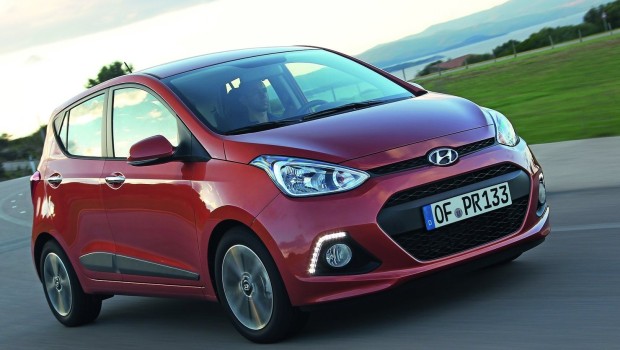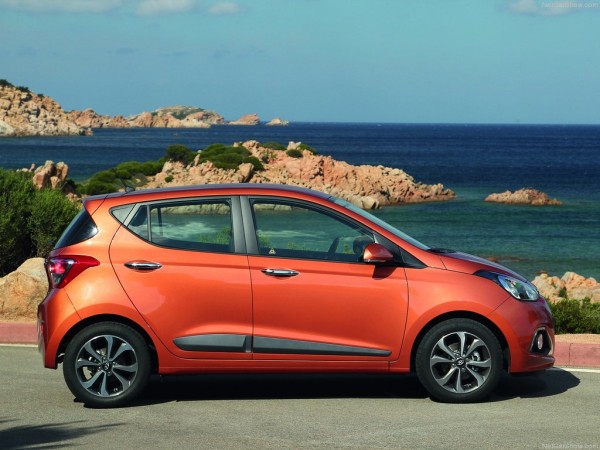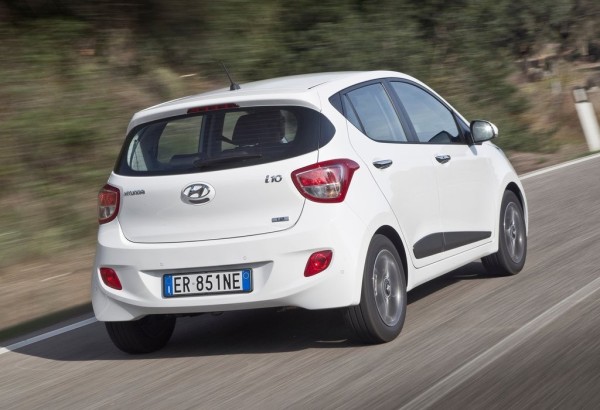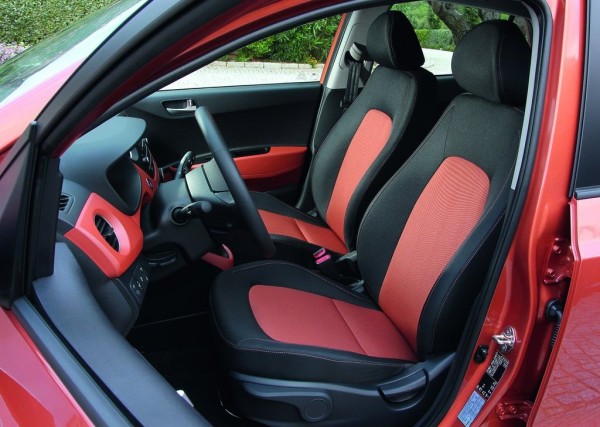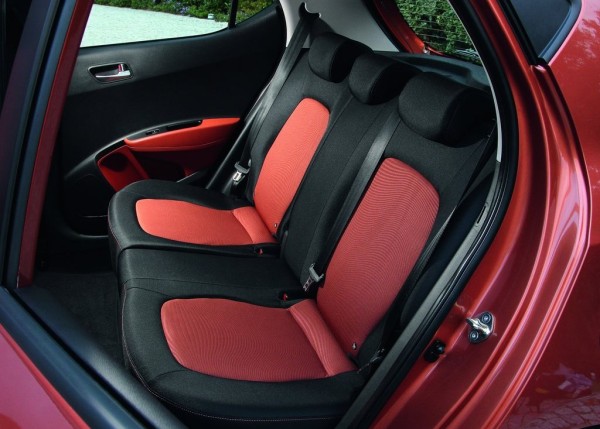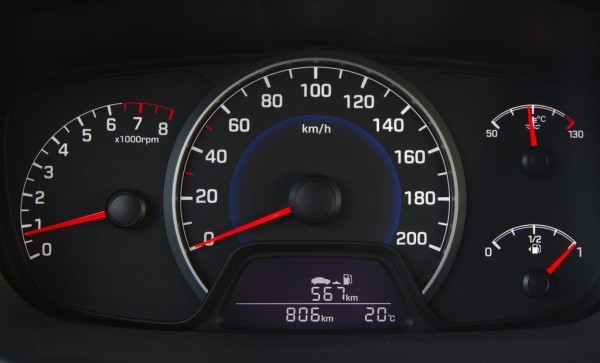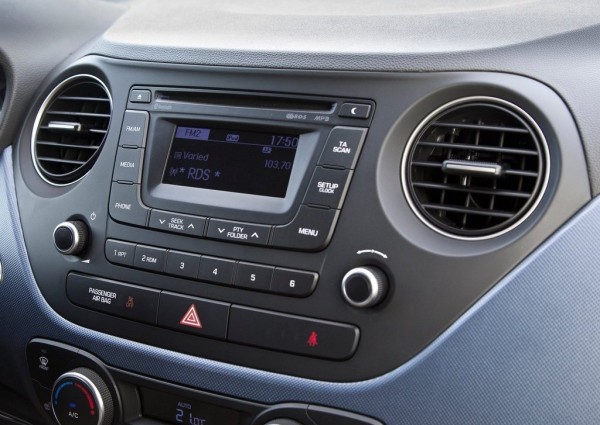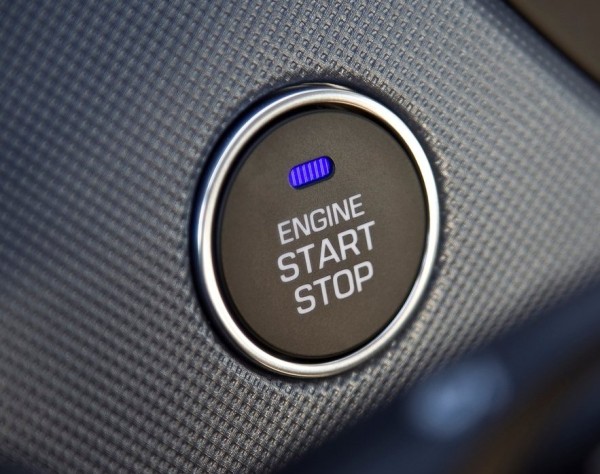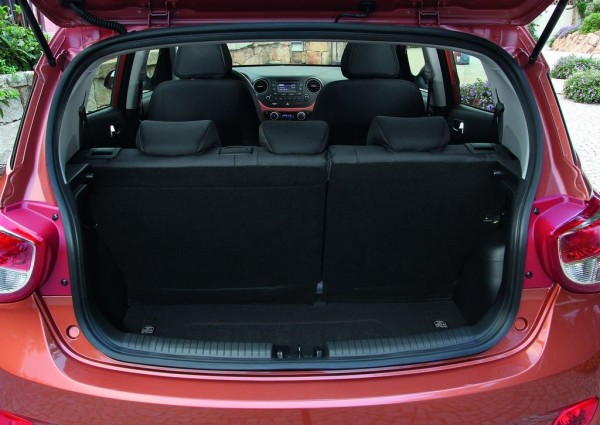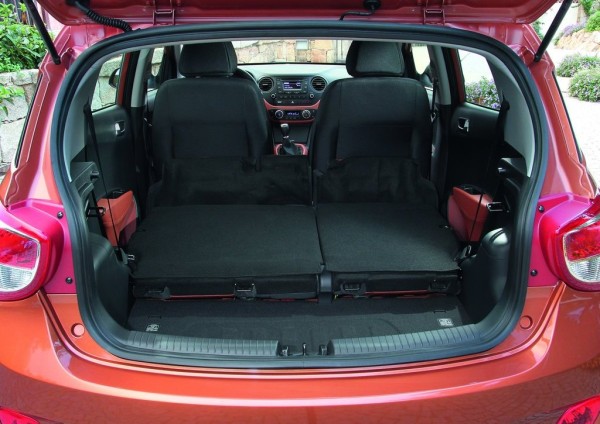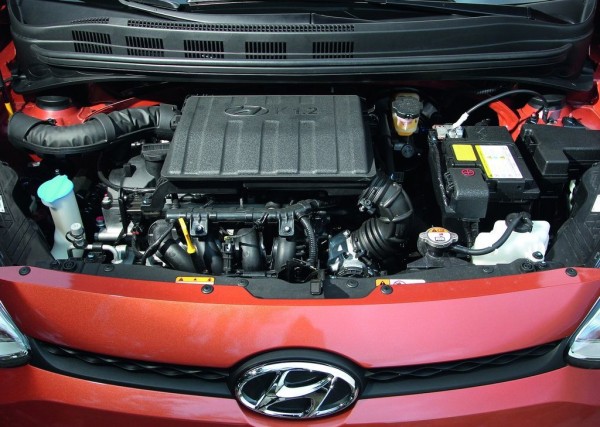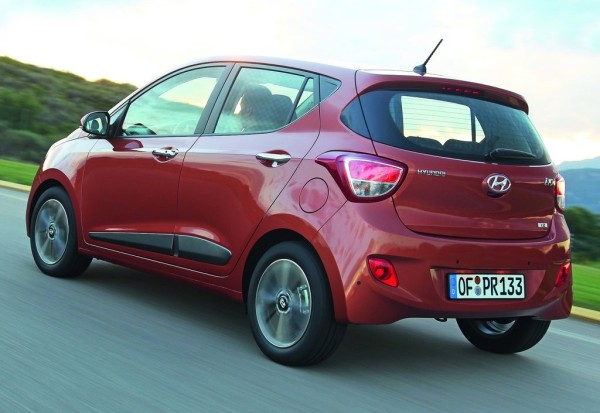Hyundai’s All New i10 Super Compact Details
Influenced by Hyundai Motor’s design philosophy, fluidic sculpture, This all new Hyundai i10 features sleek and substantial lines that emphasise the naturally athletic stance of a model which is longer, wider and lower than its predecessor. The new proportions are mirrored by a driving experience that has been developed to meet European preferences. Relocated and retuned components result in greater body and wheel control, delivering more driver involvement and ride comfort comparable to that of cars from higher segments.
The larger bodyshell of i10 yields one of the roomiest occupant cabins on the market, as well as a best-in-class 252 litres of trunk capacity. Up to 1046 litres becomes available when the rear seats are folded – also a best-in-class figure. New levels of craftsmanship can be found in the spacious interior, together with levels of comfort and safety equipment commonly only found in segments above.
Demonstrating Hyundai Motor’s confidence in its European build quality, the i10 will come with the company’s Five Year Unlimited Mileage Warranty. The industry-best package also includes five years of roadside assistance and five years of vehicle health checks – which will be offered across Europe for the first time on an A-segment Hyundai model.
STYLING & DESIGN
The importance of design to the success of i10 was not underestimated by Hyundai Motor; design is currently the number one reason European customers choose to buy the company’s vehicles in any segment, with 31% citing it as their primary purchase consideration (versus an industry average of 29%). i10 therefore offers European consumers Hyundai Motor’s latest interpretation of the company’s fluidic sculpture design philosophy.
i10 is a true European car – it was designed and engineered from the ground up at Hyundai Motor’s European R&D centre, HME TC, at Rüsselsheim, Germany, for European buyers.
The injection of European style is matched to practicality-enhancing dimensions. At 3665 millimetres (mm), i10 is 80 mm longer than its predecessor, and the longest car in the segment. Likewise, i10 goes from being the narrowest model in the A-segment to the widest at 1660 mm (+ 65 mm).
A 40 mm lowered roofline, now standing at 1500 mm, yields an athletic on-the-road stance. This is complemented by the sleek proportions of the bodyshell, in turn highlighted by the sharper belt line and side belt moulding.
Hyundai i10 has one of the most practical and spacious cabins in the sector. Innovative interior packaging gives way to segment-best trunk volume (252 litres with rear seats in place and 1046 litres with rear seats folded) and combined front and rear legroom (1890 mm).
A shallower windscreen and A-pillars offer drivers a perceivably larger field of vision, making exiting blind turns safer and manoeuvring in tight city spaces easier. Customer clinic participants cited visibility as an area where i10 particularly impressed.
The new, sleeker exterior design has a drag coefficient (Cd) of just 0,31 – the lowest in the segment – which is aided by detailed improvements such as windscreen sealing that does not protrude into the airstream. The aerodynamic shape reduces wind noise as well as fuel consumption, contributing to noise levels that are lower than those of key rivals.
i10 will be offered in a range of 11 vibrant exterior colours available in solid, metallic and pearl finishes. The solid colour range comprises Baby Elephant (grey), Morning Glory (blue) and Pure White, while the metallic range is made up of Sleek Silver, Star Dust (grey), Sweet Orange and Montano Sky (blue). The design team has matched four pearl colours to the distinctive new shape of i10: Phantom Black, Red Passion, Wine Red and Silky Beige. Individual markets will tailor the colour palettes to best suit local preferences.
Inside, the i10 offers a broader choice of seat trim options than previously seen. Base models come with a combination of cloth and vinyl in beige and black. Mid-specification models have tricot cloth in blue or orange with woven side panels in black. Premium models are similarly equipped, but also offer the option of woven pattered cloth in red with black leather-like side panels.
A major contributor to the premium feel of the interior of i10 is the coloured inlay that runs the full width of the dashboard, emphasising the available space. The trim is available in four colours – red (high-level trim only), calming blue, vibrant orange or refined beige (exclusive for entry-level trim) – and is mirrored by the gear lever surround and lower sections of the front doors.
COMFORT & CONVENIENCE
Hyundai i10, now one of the largest models in the A-segment, offers a greater number of comfort features and additional space for a more pleasurable environment for all occupants. First, the enlarged wheelbase of i10 (up 5 mm to 2385 mm) allows for a longer, wider bodyshell, which gives way to one of the roomiest cabins in its class. Further cabin space has been created by moving the car’s gearbox forward by 25 mm.
Front seat occupants can enjoy 40 mm more legroom, which stands at a best-in-class 1070 mm, as well as 16 mm additional shoulder room (1306 mm) and a generous 1008 mm of headroom.
Trunk capacity is boosted by 12% to a class-leading 252 litres (a 27-litre increase over its predecessor), easily accessed by a tailgate that opens to within just 724 mm of the ground. The rear seats fold 60:40, yielding a useful 1046 litres of storage space, accessed by one of the widest trunk openings (920 mm) in the A-segment. Uniquely for an A-segment car, all four doors can each hold a large-capacity bottle (1,0-litre size in the front doors; 0,6-litre in the rear doors); drinks holders positioned immediately rearward of the gear lever further boost i10’s functionality.
Results showed that customer clinic participants placed i10 ahead of key segment rivals in terms of both comfort and functionality, with 70% rating the car highly for ease of access and front seat roominess.
The bodyshell of i10 is stiffer, thanks to the use of high-tensile steel, tailored blanks, reinforcing loops and additional bracing, with torsional rigidity increased by 27% over its predecessor. High-tensile steel forms 29,2% of the body structure of i10 – a huge increase over the 9% utilised in original i10. The firm underpinnings not only improve the car’s impact-resistance, but yield significant improvements in noise, vibration and harshness (NVH).
Other NVH counter-measures include larger hydraulic mountings for the engine, a triple-layer dashboard bulkhead with sound-deadening panel, dual door sealing strips, and two measures to reduce wind noise – careful refinement of the shape of the door mirror mounts and moving the radio antenna towards the rear of the roof. The results of the measures are impressive, with noise levels as low as 38 decibels (dB) at idle and 65 dB on rough surfaces – noticeably below those of key rivals.
Generous standard equipment from the segment above
Hyundai Motor continues to lead the way in new technology democratisation among global automakers, appointing i10 with features and equipment usually found in B- or C-segment cars. More luxurious equipment available includes steering wheel-mounted cruise control with adjustable speed limiter, heated leather steering wheel and front seats, hill assist control, Smart key with engine start/stop button, LED running lights, as well as full automatic climate control.
Mid-specification models, anticipated to be the best-sellers across Europe, include features that customers will value highly, such as front and rear power windows, remote central locking and height adjustable driver’s seat.
Even base models feature a generous standard of specification, including central locking, trip computer, daytime running lights and a full complement of active and passive safety equipment. Hyundai i10’s ‘true value’ proposition is expected to result in buyers moving towards higher trim lines, with as many as 87% expected to opt for cars in medium and high trim.
High levels of craftsmanship
Hyundai Motor’s engineers and designers have worked hard to ensure that levels of craftsmanship found in i10 equal or exceed those typically found in B-segment cars. High-quality materials, the careful selection of colours and a thorough attention to detail leave occupants with a feeling of well-being – confirmed by customer clinic participants who found the illumination of the instruments and the design of the steering wheel, dashboard and centre console especially appealing.
The cabin of i10 contains no exposed metal, enhancing the impression of comfort and perceived quality. The full-width colour below-dashboard insert and matching trim add further sophistication to the cabin ambience. Attention to detail can be seen throughout – such as the multi-button power window cluster and the fully adjustable, cloth covered front head restraints.
Hyundai Motor’s perceived quality team was created to make sure that Hyundai Motor models leave drivers and passengers with a lasting impression of high quality, and played a vital role in the development of i10.
The team ensured that controls feel substantial yet operating forces are in line with ergonomic ideals; that surfaces of the instrument panel and touch-points in and around the car look and feel refined, with screw heads concealed or covered in key places such as around the interior door handles; and that contact points are free of lines or contours that may detract from the high-quality feel. i10 leaves drivers and passengers with. The team also made sure that all instruments and controls were easy to reach and intuitively-placed for European drivers.
ENGINES & TRANSMISSIONS
In keeping with the European focus of i10, the engineering team at HME TC in Rüsselsheim developed and tuned powertrains suited to meet the demands of the region’s buyers, and reinforce the new model’s sophisticated and refined characteristics.
Hyundai Motor has given i10 buyers a choice of two highly-developed gasoline engines driving the front wheels through five-speed manual or four-speed automatic gearboxes. The Indian-built 1,1-litre Epsilon engine has been discontinued.
i10’s 1.0-litre and 1.25-litre powerplants both belong to Hyundai Motor’s popular ‘Kappa’ engine family and incorporate a range of advanced technical features that raise power and torque, and enhance smoothness and driveability.
Outstanding features of the Kappa’s modern architecture include: dual overhead camshaft (DOHC), dual continuously variable valve timing (CVVT), a very stiff cast aluminium block with cast iron liners, aluminium cylinder head, lighter connecting rods and maintenance-free long-life timing chain.
The 1.0-litre engine also introduces a number of innovative features that reduce friction and vibration, promoting more complete combustion and increase durability. These include a crank offset by 11 mm, low-friction ‘beehive’ conical valve springs that reduce noise, piston cooling jets, valves and tappets coated in diamond-like carbon (DLC) for enhanced durability, and pistons and low-tension piston rings that are coated using long-lasting physical vapour deposition (PVD).
The 1.0-litre, three-cylinder powerplant has a power output of 66 ps from its 998cc capacity. Maximum power is produced at 5500rpm, 700 rpm earlier than in previous generation i10, while peak torque of 94Nm is available from 3500rpm. i10 with this engine and manual transmission can travel from standstill to 100 km/h in 14.9 seconds and on to a top speed of 155km/h.
Expected to take approximately 40% of total sales, the four cylinder ‘Kappa’ 1.25-litre engine, with a 1248cc capacity, offers drivers 87ps at 6000 rpm. Maximum torque of 120Nm is available to the driver from 4000rpm. When mated to manual transmission, the 1.25-litre i10 can accelerate from standstill to 100 km/h in 12,3 seconds and reach a top speed of 171 km/h.
RUNNING GEAR
As with every aspect of i10, Hyundai Motor’s European R&D team went to great lengths to ensure the new model’s suspension and running gear have been tuned to offer exceptional ride quality and refinement, and low noise levels, putting the vehicle at the top of the segment, on a par with vehicles from the class above.
The suspension system of i10 introduces major advancements over its predecessor, most notably the rear shock absorbers, which now stand vertical. The change in their orientation greatly reduces friction, resulting in greater wheel control and handling, and improved ride quality, benefitting occupant comfort. At the front of the car, revised hard points for the subframe-mounted MacPherson strut suspension reduce ‘nose dive’ during hard braking.
Geometry changes to suspension components and steering arms, and the introduction of side loading springs, deliver improved feedback. The steering system employs electric power-assistance and requires 2,9 turns lock-to-lock for a 9,56-metre turning circle.
As standard, the i10’s braking system features 241 (1,0 models) or 252 mm (1,25 models) diameter ventilated discs at the front and 234 mm diameter solid discs at the rear. The system was tested and refined over a 12-kilometre Alpine route that features elevation changes of 1.600 metres and includes numerous long downhill slopes, subjected the brakes to prolonged operation. Its height above sea level means it is only open between May and October, during which the development team made repeated numbers of high-speed stops with fully-laden test cars. To maximise braking power and stability, an anti-lock braking system (ABS), electronic brake force distribution (EBD) and electronic stability control (ESC) are all fitted as standard.
Just as importantly, Hyundai Motor’s European engineers tuned i10’s brakes to deliver the feel and feedback demanded by the region’s drivers, employing procedures originally developed to refine the company’s C- and D-segment cars.
Hyundai Motor’s new A-segment contender was tested extensively for two years throughout Europe and in south-east Asia to ensure it is as well-suited to the wide variety of driving conditions found in the continent as it is to the region’s driving tastes. Hot weather tests were conducted in Cadiz and Granada in Spain, while cold weather testing took place at high altitude in Switzerland and on frozen lakes in Sweden, in temperatures as low as minus 25°C. Testing of road behaviour and stability control systems took the car as far away as northern Japan and Hyundai Motor’s Namyang research and development centre in Korea.
SAFETY
Safety is a top priority for Hyundai Motor and i10 benefits from the latest technologies, including several from the segment above, to make it one of the safest vehicles in its segment. A range of active and passive safety features ensure maximum protection for occupants and pedestrians alike.
Active safety features such as electronic stability control (ESC) and vehicle stability management (VSM) are fitted as standard for the first time on an A-segment car from Hyundai Motor, as is a tyre pressure monitoring system.
The ESC was carefully tuned to be as nonintrusive as possible, creating a more natural-feeling and comfortable driving experience. Achieving this with A-segment vehicles is usually difficult, due to typically higher centres of gravity and relatively short wheelbases, which can result in low loads on the rear of the vehicle and subsequent instability – characteristics i10 mitigates thanks to its athletic proportions. High-grip testing was carried out at Hyundai Motor’s Namyang R&D centre in Korea, while the system’s low-grip behaviour was tested and refined in northern Sweden and in northern Japan.
i10’s impressive passive safety equipment includes six airbags – two front, two front side and two full-length curtain – as standard, offering outstanding protection to occupants in the event of a collision. Seatbelt reminders for all occupants and automatic central locking are also standard features.
The stronger bodyshell created for Hyundai i10 uses high-strength steel and incorporates ring-shaped reinforcing loops within the B- and C-pillars, and across the floor pan and roof, plus additional bracing at the front between the cowl and suspension towers, to improve rigidity and safety.


